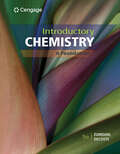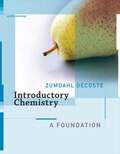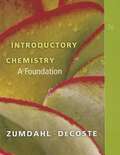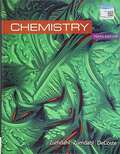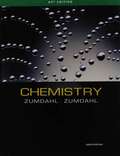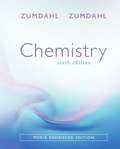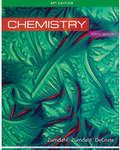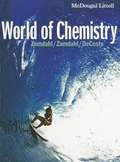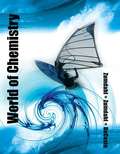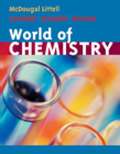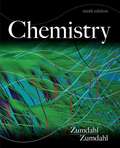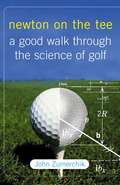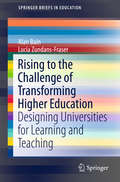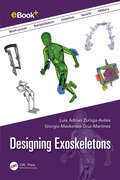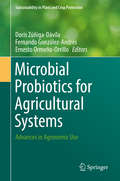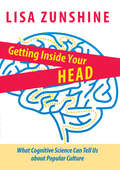- Table View
- List View
Introductory Chemistry: A Foundation, AP® Edition
by Steven S. Zumdahl Donald J. DeCosteA bestseller among introductory texts, Zumdahl's "Introductory Chemistry series is a complete teaching system that places a unique emphasis on developing problem-solving skills with a thoughtful step-by-step approach applicable to chemistry and other disciplines. Another important goal of the series is to connect chemistry to real-life experiences, with engaging applications and colorful graphics."Basic Chemistry, 4/e, (Chapters 1-15) provides basic coverage of chemical concepts and applications through acids and bases. Inclusion of acids and bases is new."Introductory Chemistry, 4/e, (Chapters 1-18) expands coverage with the addition of equilibrium, oxidation-reduction reactions, electrochemistry, radioactivity, and nuclear energy. "Introductory Chemistry: A Foundation, 4/e (Chapters, 1-20) includes two chapters which provide a brief introduction to organic and biological chemistry.
Introductory Chemistry: A Foundation
by Steven S. Zumdahl Donald J. DeCosteSucceed in your course with INTRODUCTORY CHEMISTRY: A FOUNDATION! This best-selling text combines enhanced problem-solving structure with substantial pedagogy to help you become a successful problem solver. Early coverage of chemical reactions, accessible explanations and visualizations, and an emphasis on everyday applications facilitates understanding. The authors' step-by-step approach has already helped hundreds of thousands of student's master chemical concepts and develop strong problem-solving skills. Interactive study aids in OWLv2, such as ChemWork Problems and Adaptive Learning Activities, help students master concepts.
Introductory Chemistry: A Foundation
by Steven S. Zumdahl Donald J. DeCosteThe Sixth Edition of Introductory Chemistry: A Foundation offers unparalleled teaching and learning resources, with a robust technology package, in addition to the superior problem-solving pedagogy, engaging writing style, and strong emphasis on everyday applications that comprise the hallmarks of this best-selling text. Chemical reactions are covered early, to capture student interest, leaving more abstract material for later chapters. The authors explain chemical concepts by starting with the basics, using symbols or diagrams, and concluding by encouraging students to test their own comprehension of the solution. <p><p>This step-by-step approach helps students develop critical problem-solving skills. Also, the accessible explanations and visualizations throughout the text motivate students and engage them in the material by helping them to connect abstract chemical principles to real-life experiences. The pedagogy includes chapter-opening discussions that introduce students to relevant applications and Chemistry in Focus boxes that describe everyday applications of chemistry such as artificial sweeteners, foaming chewing gum, and fake fats. Current applications appear throughout the text with easy-to-understand explanations and analogies.
Introductory Chemistry: A Foundation
by Steven S. Zumdahl Donald J. DecosteThe Lab Manual for INTRODUCTORY CHEMISTRY: A FOUNDATION, 6th Edition, is a valuable tool designed to enhance your classroom experience. Lab activities, objectives, materials lists, step-by-step procedures, illustrations, review questions and more are all included.
Chemistry: A Foundation
by Steven S. Zumdahl Zumdahl Donald J. DeCoste Digital Consultant and Contributor Gretchen AdamsLearn the skills you need to succeed in your chemistry course with CHEMISTRY, Tenth Edition. <p><p>This trusted text has helped generations of students learn to think like chemists and develop problem-solving skills needed to master even the most challenging problems. Clear explanations and interactive examples help you build confidence for the exams, so that you can study to understand rather than simply memorize. Combined with the online resources and instant feedback in OWLv2, you'll be on your way to developing a deeper understanding of chemistry concepts and solving complex problems in all aspects of your life.
Chemistry: Advanced Placement Edition
by Steven S. Zumdahl Susan A. ZumdahlCHEMISTRY allows the reader to learn chemistry basics quickly and easily by emphasizing a thoughtful approach built on problem solving. For the Eighth Edition, authors Steven and Susan Zumdahl have extended this approach by emphasizing problem-solving strategies within the Examples and throughout the text narrative. CHEMISTRY speaks directly to the reader about how to approach and solve chemical problems--to learn to think like a chemist--so that they can apply the process of problem-solving to all aspects of their lives.
Chemistry
by Steven S. Zumdahl Susan A. ZumdahlSteven and Susan Zumdahl's CHEMISTRY 8e brings together the solid pedagogy, easy-to-use media, and interactive exercises that today's instructors need for their general chemistry course. Rather than rote memorization, CHEMISTRY emphasizes a thoughtful approach built on problem-solving. For the Eighth Edition, the authors have extended this approach by emphasizing problem-solving strategies within the Examples and throughout the text narrative. The text speaks directly to the student about how to approach and solve chemical problems--to learn to think like a chemist--so that they can apply the process of problem-solving to all aspects of their lives. Students are provided with the tools to become critical thinkers: to ask questions, to apply rules and develop models, and to evaluate the outcome.
Chemistry
by Steven S. Zumdahl Susan A. ZumdahlAuthors Steven and Susan Zumdahl offer all the elements instructors need for their general chemistry course. They bring a conceptual approach to chemistry and integrate problem-solving skills throughout, helping students transition from theory to practice. A strong emphasis on models, real-world applications, and visual learning prevails throughout the text. The Seventh Edition seamlessly integrates the strengths of the Zumdahl approach through a comprehensive and interwoven print and technology program. Enhanced Sample Exercises, online homework problems, and Classroom Response System content help instructors assess conceptual understanding and problem-solving skills, while new animations and images support visual learning. In addition, Houghton Mifflin offers implementation services through our TeamUP program to help instructors and students get the most out of the text and its supplements. New! Reality Checks at the end of selected Sample Exercises prompt students to ensure that their answers are reasonable. New! The expanded art program includes new electrostatic potential maps in Chapter 8, "Bonding" that illustrate bond and molecular polarity. New! The redesigned For Review section now includes bulleted key concepts for the chapter, as well as review questions of which approximately 50% are new. New! Integrative Problems in the end-of-chapter material assess students' cumulative understanding of multiple concepts and skills presented in previous chapters. End-of-chapter questions also include collaborative Active Learning Question (formerly In-Class Discussion Questions), Exercises organized by topic, Additional Exercises not keyed by topic, integrative Challenge Problems, and comprehensive Marathon Problems. New! Algorithmically-generated Test Questions as well as Conceptual Questions are available in HM Testing, all coded by level of difficulty to allow instructors to more easily choose appropriate test items. New! Animations with assignable exercises appear on the Online Study Center and Student CD. New! HM ClassPresent v.3 includes new animations and videos as well as enhanced search functionality. Eduspace Online Learning Tool features two kinds of problems: ChemWork interactive online homework and end-of-chapter algorithmic questions with links to corresponding textbook pages and media for student reference at point of learning.
Chemistry (5th edition)
by Steven S. Zumdahl Susan A. ZumdahlThe fifth edition of Chemistry presents the concepts of chemistry in a clear, interesting, and student-friendly manner. Since visual material is especially important for learning general chemistry, which typically presents a pictorial view of chemical concepts, the illustrations representing the microscopic world of chemistry have been redone in this edition to improve their clarity and appearance. Special illustrations and color photographs integrate descriptive chemistry with chemical principles, and many new Chemical Impact features emphasize practical applications of newly learned concepts.
Chemistry (6th Edition, Media Enhanced Edition)
by Steven S. Zumdahl Susan A. ZumdahlConceptual approach to problem-solving, high-quality end-of-chapter problems, student friendly writing style and a strong emphasis on models and real-world applications are the highlights of this Chemistry 6th Edition. The new Media Enhanced Edition provides students with easy access to the media resources that support the goals of the text.
Chemistry (7th edition)
by Steven S. Zumdahl Susan A. ZumdahlAuthors bring a conceptual approach to chemistry and integrate problem-solving skills throughout, helping students transition from theory to practice. A strong emphasis on models, real-world applications, and visual learning prevails throughout the text.
Chemistry, AP* Edition
by Steven S. Zumdahl Susan A. ZumdahlThis fully updated Ninth Edition of Steven and Susan Zumdahl's CHEMISTRY brings together the solid pedagogy, easy-to-use media, and interactive exercises that today's instructors need for their general chemistry course. Rather than focusing on rote memorization, CHEMISTRY uses a thoughtful approach built on problem-solving. For the Ninth Edition, the authors have added a new emphasis on critical systematic problem solving, new critical thinking questions, and new computer-based interactive examples to help students learn how to approach and solve chemical problems--to learn to think like chemists--so that they can apply the process of problem solving to all aspects of their lives. Students are provided with the tools to become critical thinkers: to ask questions, to apply rules and develop models, and to evaluate the outcome. In addition, Steven and Susan Zumdahl crafted ChemWork, an online program included in OWL Online Web Learning to support their approach, much as an instructor would offer support during office hours. ChemWork is just one of many study aids available with CHEMISTRY that supports the hallmarks of the textbook--a strong emphasis on models, real world applications, visual learning, and independent problem solving. Available with InfoTrac Student Collections http://gocengage. com/infotrac.
Chemistry, AP* Edition
by Steven S. Zumdahl Susan A. ZumdahlThis fully updated Ninth Edition of Steven and Susan Zumdahl's CHEMISTRY brings together the solid pedagogy, easy-to-use media, and interactive exercises that today's instructors need for their general chemistry course. Rather than focusing on rote memorization, CHEMISTRY uses a thoughtful approach built on problem-solving. For the Ninth Edition, the authors have added a new emphasis on critical systematic problem solving, new critical thinking questions, and new computer-based interactive examples to help students learn how to approach and solve chemical problems--to learn to think like chemists--so that they can apply the process of problem solving to all aspects of their lives. Students are provided with the tools to become critical thinkers: to ask questions, to apply rules and develop models, and to evaluate the outcome. In addition, Steven and Susan Zumdahl crafted ChemWork, an online program included in OWL Online Web Learning to support their approach, much as an instructor would offer support during office hours. ChemWork is just one of many study aids available with CHEMISTRY that supports the hallmarks of the textbook--a strong emphasis on models, real world applications, visual learning, and independent problem solving. Available with InfoTrac Student Collections http://gocengage. com/infotrac.
Chemistry
by Steven S. Zumdahl Susan A. Zumdahl Donald J. DeCosteLearn the skills you need to succeed in your chemistry course with CHEMISTRY, Tenth Edition. This trusted text has helped generations of students learn to “think like chemists” and develop problem-solving skills needed to master even the most challenging problems. Clear explanations and interactive examples help you build confidence for the exams, so that you can study to understand rather than simply memorize.
World Of Chemistry
by Steven S. Zumdahl Susan A. Zumdahl Donald J. DeCosteEasy to read and accessible to all students, WORLD OF CHEMISTRY includes National Geographic images and visuals, numerous problem-solving examples, a wide range of end-of-chapter exercises, and real world applications that truly bring the "world of chemistry" together in one unique central learning resource. Offering a rigorous but understandable introduction to chemistry, this program reflects the authors' belief that chemistry is something students must construct for themselves with the help of the teacher, content support including introductions to National Geographic Explorers, and laboratory exploration. This new 4th edition has been completely redesigned to include National Geographic images, Explorers, and the incorporation of new engineering features.
World of Chemistry: Easyplanner
by Steven S. Zumdahl Susan L. Zumdahl Donald J. DeCosteNIMAC-sourced textbook
World of Chemistry
by Steven S. Zumdahl Susan L. Zumdahl Donald J. DeCosteChemistry textbooks are written differently from non-technical textbooks. With this in mind, be aware that reading five pages in a chemistry textbook will probably take much more time than reading five pages in an English or a history textbook. If you want to understand this chemistry text, prepare to spend a great deal of time reading each section within a chapter. If you flip through this book, you will notice many examples, explanations, diagrams, charts, symbols, and photos to read, analyze, and interpret. You should read the text in each section and incorporate these visuals in your reading. You will quickly find that these visuals are very useful in helping you understand the subject matter.
World of Chemistry (Second Edition)
by Steven S. Zumdahl Susan L. Zumdahl Donald J. DecosteWorld of Chemistry presents the right balance of concepts and applications, emphasizing active learning and encouraging students to solve problems creatively.
Chemistry
by Steven Zumdahl Susan ZumdahlNever HIGHLIGHT a Book Again! Virtually all of the testable terms, concepts, persons, places, and events from the textbook are included. Cram101 Just the FACTS101 studyguides give all of the outlines, highlights, notes, and quizzes for your textbook with optional online comprehensive practice tests. Only Cram101 is Textbook Specific. Accompanys: 9781133611097 .
Newton on the Tee
by John ZumerchikLike no other sport, golf obsesses those poor souls who hope to master its subtleties and abundant complexities. One shot is hit like a dream, the next a nightmare. As a result, the game's disciples have embraced any and all techniques endorsed by pros and hackers, poets and philosophers (these days a good walk is often spoiled by tripping over a sandtrap's worth of Zen meditations and mystical tomes). But while so many have journeyed through golf's metaphysics, no one has presented a readable, compelling look at the science of the game -- until now. In Newton on the Tee, accomplished science writer John Zumerchik examines, explores, and explains to us the endless details that make golf such a tantalizing pursuit. Written in language accessible to even the most scientifically disinclined, Zumerchik's book delves into areas of supreme importance to every golfer, including: The Physics of the Sweet Swing: The universal principles shared by all those rhythmic and well-timed swings you see on TV but not in the mirror Mind Over Muscle: How the brain affects and controls the movements of the body (and why confidence is the golfer's most indispensable tool) Getting the Ball from Here to There: Decoding the vagaries of launch angles, spin, lift, and gravity that make the difference between walking happily down the fairway and tramping into the bunkers Probability and Statistics: Understanding the mathematics of golf, and a by-the-numbers appraisal of golf's greatest legends With a firm grasp of both his subject and his 7-iron, Zumerchik takes the reader through all these topics and more, in an entertaining and enlightening work that will give every golfer something to chew on besides his or her nails, and make clear and comprehensible the hundred-and-thirty-five things you shouldn't think about during your backswing.
Rising to the Challenge of Transforming Higher Education
by Lucia Zundans-Fraser Alan BainCreating a successful and distinctive approach to learning and teaching at scale is a challenge facing all universities. This brief presents the Self-Organizing University (SOU), a transformational whole-of-organization solution for the design, delivery, and evaluation of learning and teaching in all its forms. It describes the elements of the SOU approach along with the implementation process and expected outcomes. It also explains the rationale and research base for each element of the model and how they are connected to create a university-wide model of learning and teaching. It includes guidance for anyone responsible for institutional improvement in the learning and teaching space.
Designing Exoskeletons
by Luis Adrian Zuñiga-Aviles Giorgio Mackenzie Cruz-MartinezDesigning Exoskeletons focuses on developing exoskeletons, following the lifecycle of an exoskeleton from design to manufacture. It demonstrates how modern technologies can be used at every stage of the process, such as design methodologies, CAD/CAE/CAM software, rapid prototyping, test benches, materials, heat and surface treatments, and manufacturing processes. Several case studies are presented to provide detailed considerations on developing specific topics. Exoskeletons are designed to provide work-power, rehabilitation, and assistive training to sports and military applications. Beginning with a review of the history of exoskeletons from ancient to modern times, the book builds on this by mapping out recent innovations and state-of-the-art technologies that utilize advanced exoskeleton design. Presenting a comprehensive guide to computer design tools used by bioengineers, the book demonstrates the capabilities of modern software at all stages of the process, looking at computer-aided design, manufacturing, and engineering. It also details the materials used to create exoskeletons, notably steels, engineering polymers, composites, and emerging materials. Manufacturing processes, both conventional and unconventional are discussed—for example, casting, powder metallurgy, additive manufacturing, and heat and surface treatments. This book is essential reading for those in the field of exoskeletons, such as designers, workers in research and development, engineering and design students, and those interested in robotics applied to medical devices.
Microbial Probiotics for Agricultural Systems: Advances in Agronomic Use (Sustainability in Plant and Crop Protection)
by Doris Zúñiga-Dávila Fernando González-Andrés Ernesto Ormeño-OrrilloThe book is a comprehensive compilation of the most recent advances in the practical approach of the use of microbial probiotics for agriculture. Unlike the rest of the publications about biofertilizers, this book bridges the gap between the lab studies (molecular, physiological, omics, etc.) and the agronomic application.
Getting Inside Your Head: What Cognitive Science Can Tell Us about Popular Culture
by Lisa ZunshineUsing the psychological concept called theory of mind, Lisa Zunshine explores the appeal of movies, novels, paintings, musicals, and reality television.Winner of the CHOICE Outstanding Academic Title of the Choice ACRLWe live in other people's heads: avidly, reluctantly, consciously, unaware, mistakenly, and inescapably. Our social life is a constant negotiation among what we think we know about each other's thoughts and feelings, what we want each other to think we know, and what we would dearly love to know but don't.Cognitive scientists have a special term for the evolved cognitive adaptation that makes us attribute mental states to other people through observation of their body language; they call it theory of mind. Getting Inside Your Head uses research in theory of mind to look at movies, musicals, novels, classic Chinese opera, stand-up comedy, mock-documentaries, photography, and reality television. It follows Pride and Prejudice’s Mr. Darcy as he tries to conceal his anger, Tyler Durden as he lectures a stranger at gunpoint in Fight Club, and Ingrid Bergman as she fakes interest in horse races in Notorious.This engaging book exemplifies the new interdisciplinary field of cognitive cultural studies, demonstrating that collaboration between cognitive science and cultural studies is both exciting and productive.

